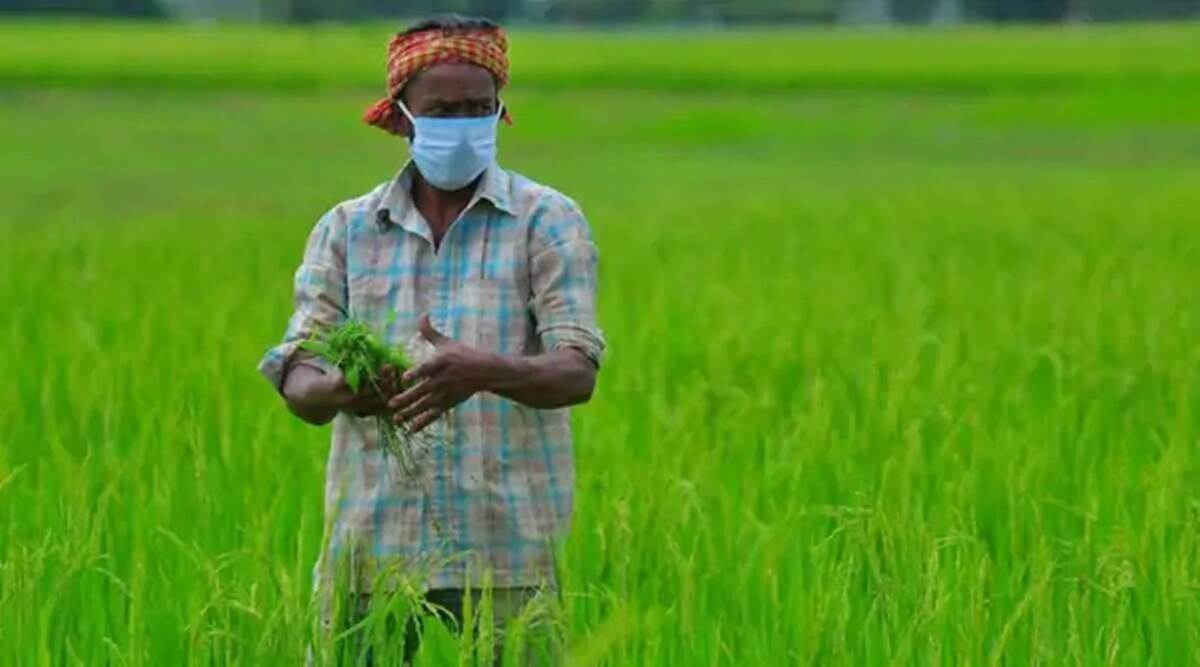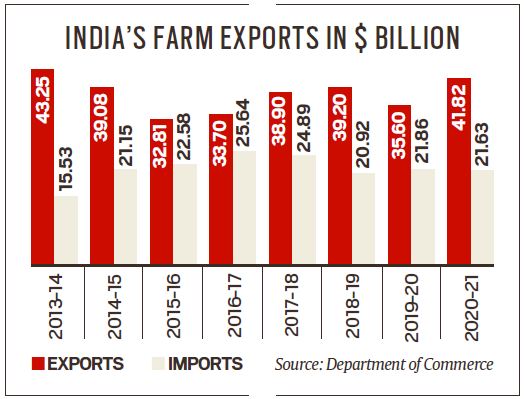 Many ports are already reporting a substantial decline in daily labour attendance for loading/unloading activity. The number of vessels calling has also fallen in the last 10-15 days, as the owners are hesitant to load cargo from India.
Many ports are already reporting a substantial decline in daily labour attendance for loading/unloading activity. The number of vessels calling has also fallen in the last 10-15 days, as the owners are hesitant to load cargo from India. India’s agricultural exports grew 17.5 per cent to cross $41.8 billion in 2020-21. This came even as the country’s overall merchandise exports fell 7.2 per cent to $290.8 billion, from $313.4 billion in 2019-20.
The farm sector’s standout export performance, the best since the $43.25 billion of 2013-14, was thanks to a good monsoon, agriculture production being relatively unaffected by the Covid-19-induced lockdown, and a steep surge in global commodity prices. It is also in line with GDP numbers: Agricultural growth for 2020-21 is estimated at 3 per cent, even as the Indian economy contracted by 6.5 per cent.
Whether the same story can be repeated this year, however, remains to be seen: The Met Department has forecast a normal southwest monsoon, while the UN Food and Agricultural Organization’s world food price index hit an 83-month-high in April. But the pandemic’s spread to the rural hinterland – unlike last year, when cases were predominantly reported from urban centres – could impact shipments from India, at least temporarily.
Many ports are already reporting substantial drop in daily labour attendance for loading/unloading activity. The number of vessels calling has also fallen in the last 10-15 days, as the owners are hesitant to load cargo from India. In Andhra Pradesh’s Kakinada, a major port for rice exports, only up to 20 barges (each of 400-500 tonnes) are being allowed to be loaded into vessels per day, as against 50-60 in normal times. Vizag port has, likewise, imposed restrictions on labour working time from 6 to 11 in the morning.
Last year’s agri-export boom was led by non-basmati rice, with a record 13.09 million tonnes (mt) valued at $4.80 billion going out of the country. Together with 4.63 mt of basmati (again a record) worth $4.02 billion, it has further consolidated India’s position as the world’s biggest rice exporter.

“There could be some setback due to the current disruptions. But exports should do well this year as well, because of high international prices and our rice being the most competitive,” said Nitin Gupta, Vice President at Olam Agro India Ltd. White rice with 25% broken grains is now being offered from India at about $360 per tonne, lower than the $470 from Vietnam and $490 from Thailand. Indian parboiled rice with 5% brokens, too, is quoting at $370 per tonne, compared to $440 from Pakistan.
But it isn’t just rice. The country also registered all-time-high exports of sugar ($2.79 billion), spices ($3.98 billion) and processed fruits & vegetables ($1.12 billion) in 2020-21. Other exports that did well included raw cotton (from $1.06 billion in 2019-20 to $1.90 billion in 2020-21) and oil-meals (from $827.9 million to $1.58 billion). India, last year, even became a significant exporter of wheat (2.09 mt) and maize (3 mt) for the first time after 2014-15.
“Covid is a concern for now, but the prospects for both wheat and maize exports look good, as the international markets are supportive,” pointed out Amit Takkar, managing director of Conifer Commodities Pvt. Ltd. Wheat sourced from Gujarat, Rajasthan and Madhya Pradesh at below the minimum support price of Rs 19,750/tonne ($269) is being shipped out at around $280 per tonne after adding costs of cleaning, bagging, transport and loading at Kandla or Mundra ports. This price is fairly competitive vis-à-vis wheat from Australia ($290-300), European Union/France ($300) or Ukraine/Russia ($270-280), especially for supplying to Bangladesh, United Arab Emirates and South-East Asian markets.
India’s agricultural exports had zoomed from a mere $7.53 billion in 2003-04 to $43.25 billion in 2013-14 during the previous UPA regime. This came on the back of a bull run in global commodity prices, which ended just when the current NDA government took over. Exports nosedived to $32.81 billion by 2015-16, before steadily recovering to $41.82 billion in 2020-21. The agricultural trade surplus, which had narrowed from $27.72 billion to $8.05 billion between 2013-14 and 2016-17 due to rising imports, has also since rebounded to $20.19 billion in 2020-21.
- The Indian Express website has been rated GREEN for its credibility and trustworthiness by Newsguard, a global service that rates news sources for their journalistic standards.

